Responsibilities and Privileges
Responsibilites
The 1989 document Domus Ecclesiae (Norms for the Granting the Title of Minor Basilica) from the Congregation for Divine Worship and Discipline of the Sacraments details the certain responsibilites and privileges of a minor basilica. A minor basilica is to have a special focus on the Sacred Liturgy and fostering great care in its praxis. The seasons of Advent, Christmas, Lent, and Easter are to be prepared and carried out with special care. The word of God is to be proclaimed in homilies or special sermons. Sacred music is to be of special importance at liturgical celebrations. Finally, approved forms of devotion are to be fostered.
As a basilica is in communion with the Supreme Pontiff and thereby the cathedra of Peter by way of a special bond, each year, the following feasts and days must be celebrated with particular care:
- the Feast of the Chair of Saint Peter (February 22)
- the Solemnity of Saints Peter and Paul, Apostles (June 29)
- the anniversary of the Supreme Pontiff's election (March 13) or inauguration into the supreme ministry (March 19)
Privileges - Receiving a Plenary Indulgence
In Catholicism, the faithful have many opportunities to obtain indulgences. According to the Catechism of the Catholic Church, no. 1471, "An indulgence is a remission before God of the temporal punishment due to sins whose guilt has already been forgiven." Indulgences may be plenary (meaning "full") or partial. They can be applied to the person desiring it or the dead—they cannot be applied to any other living person. For a more detailed explanation of indulgences, you can look at this Indulgence Booklet, but the basics are here below.
Plenary indulgences can be obtained only once per day, while partial indulgences can be obtained more than once per day. According to The Enchiridion of Indulgences (EI), no. 21, "To acquire a plenary indulgence it is necessary to perform the work to which the indulgence is attached and to fulfill the following three conditions: sacramental confession, eucharistic Communion, and prayer for the intention of the Sovereign Pontiff. It is further required that all attachment to sin, even venial sin, be absent. If the latter disposition is in any way less than perfect or if the prescribed three conditions are not fulfilled, the indulgence will be partial only."
- It is most desirable to receive Holy Communion within Mass, however, any lawful reception is acceptable.
- In praying for the intention of the Supreme Pontiff, one Our Father and one Hail Mary suffice, although each person is free to recite any other prayer with piety and devotion. It is not required to know what the intention of the Holy Father is, just that you offer your prayers for it.
- Sacramental confession must be within 20 days (before or after) of performing the indulgenced work. One sacramental confession suffices for gaining several plenary indulgences. However, a separate reception of Holy Communion and Prayers for the Pontiff's intention is necessary for each plenary indulgence.
Visiting a Church or Basilica
Each church in Catholicism consecrated to divine worship has at least three dates each year where the faithful have the oppportunity to obtain a plenary indulgence. These dates, found in the Enchiridion, nos. 65 and 66, are:
- on the celebration of the title (i.e. the saint the church is named after),
- on August 2nd, the *Feast of the Portiuncula (only if it is the parish church or cathedral church), and,
- on the anniversary of the consecration of the church and/or the church's altar
The indulgenced act is devoutly visiting the church (or altar) and reciting the Lord's Prayer and a Profession of Faith (the Apostles' or Nicene Creed). The visit to the church to obtain the indulgence can be made any time between "noon of the preceding day to midnight at the close of the day itself." (EI, 18)
For a basilica, the opportunities for plenary indulgences increase due to its special bond with the Holy Father! Domus Ecclesiae says in IV.2 that "the faithful who devoutly visit the basilica and within it participate in any sacred rite or at least recite the Lord's Prayer and the profession of faith may obtain a plenary indulgence under the usual conditions." Thus, attending Mass, any sacrament, or a funeral would fulfill the indulgenced act as well as the option to recite the Our Father and Profession of faith. It then lists six dates on which the faithful can gain the plenary indulgence by visiting the basilica. The dates proper to Our Lady of Consolation are listed at the end of each line.
- on the anniversary of the dedication of the same basilica; (June 25 - dedicated by then-Bishop Samuel Stritch in 1925)
- on the day of the liturgical celebration of the title; (May 25 - Solemnity of Our Lady of Consolation)
- on the Solemnity of Saints Peter and Paul, Apostles; (June 29)
- on the anniversary of the granting of the title of basilica; (October 21 - granted by Saint Paul VI in 1971)
- once a year on a day to be determined by the local Ordinary;
- once a year on a day freely chosen by the each of the faithful.
Here at Our Lady of Consolation, there are three more days of the year when a person can obtain a plenary indulgence by visiting the basilica and reciting the Lord's Prayer and Profession of Faith.
- May 4 - the anniversary of the dedication of the High Altar, Consolation Altar, and Sorrows Altar by Bishop Stritch in 1930. (EI, n. 66)
- August 2 - the Feast of the Portiuncula (EI, n. 65)
- The Feast of the Portiuncula commemorates Saint Francis of Assisi requesting a plenary indulgence be granted to all who visited the Portiuncula, the little chapel Francis himself restored, where he began his Order, and where he ultimately died. The Portiuncula is now housed within the Basilica of Our Lady of the Angels in Assisi. Originally only granted to the Portiuncula itself, then extended over the years to all Franciscan churches, the indulgence has now been granted to all parish churches and cathedral churches.
- October 4 - the Solemnity of Saint Francis of Assisi, Founder of the Three Orders (EI, n. 68)
- As the basilica is under the care of the Conventual Franciscans, "a plenary indulgence is granted to the faithful, who devoutly visit a church or oratory of Religious on the Feast of the canonized Founder, and there recite one Our Father and the Creed."
Symbols of Basilicas
Symbols of Basilicas
Traditionally, there are four symbols that indicate a church is a basilica. Three of them involve the church building itself and one involves the rector. The rector is the priest that holds the office of presiding over an ecclesiastical institution, in this case, the basilica.
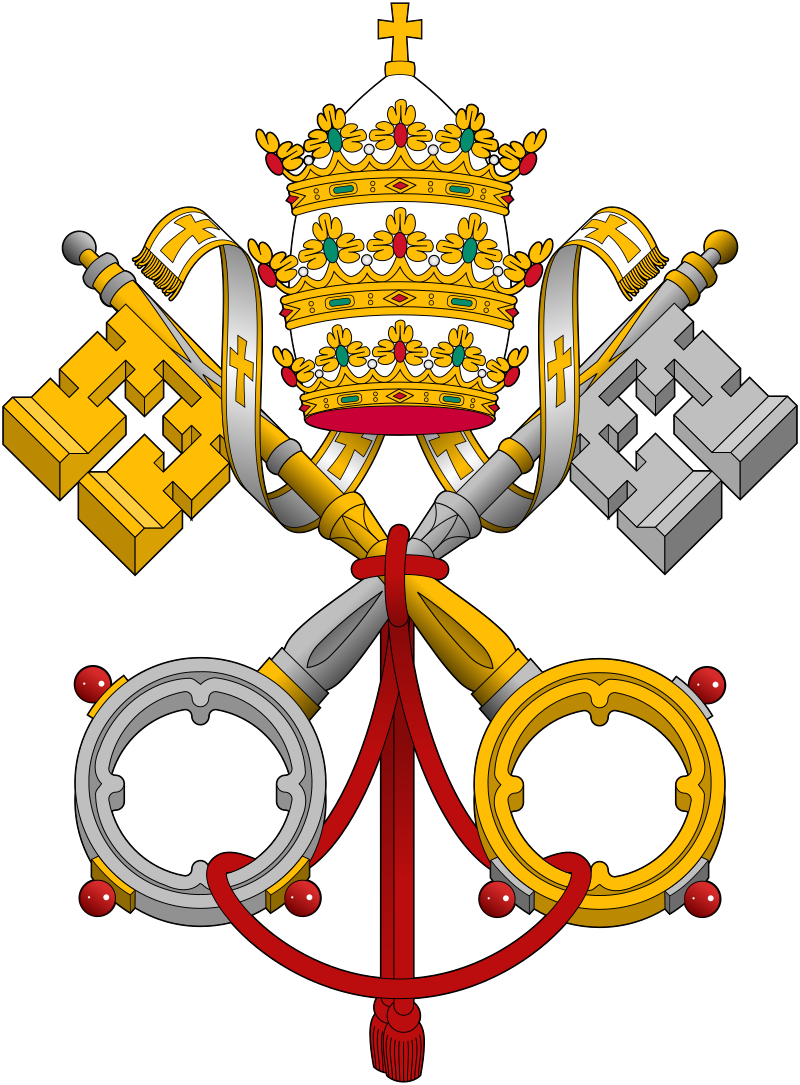 The papal symbol, known as the Keys of Heaven or Saint Peter's Keys is permitted to be displayed on the basilica itself, on sacred furnishings, and on the seal of the basilica. The "crossed keys" are a reminder of what our Lord promised to Peter and his successors: "I will give you the keys to the kingdom of heaven. Whatever you bind on earth shall be bound in heaven, and whatever you loose on earth shall be loosed in heaven." (Matthew 16:19). The presence of the keys and the papal tiara are a visible sign of the continuous relationship of the basilica to the Supreme Pontiff.
The papal symbol, known as the Keys of Heaven or Saint Peter's Keys is permitted to be displayed on the basilica itself, on sacred furnishings, and on the seal of the basilica. The "crossed keys" are a reminder of what our Lord promised to Peter and his successors: "I will give you the keys to the kingdom of heaven. Whatever you bind on earth shall be bound in heaven, and whatever you loose on earth shall be loosed in heaven." (Matthew 16:19). The presence of the keys and the papal tiara are a visible sign of the continuous relationship of the basilica to the Supreme Pontiff.
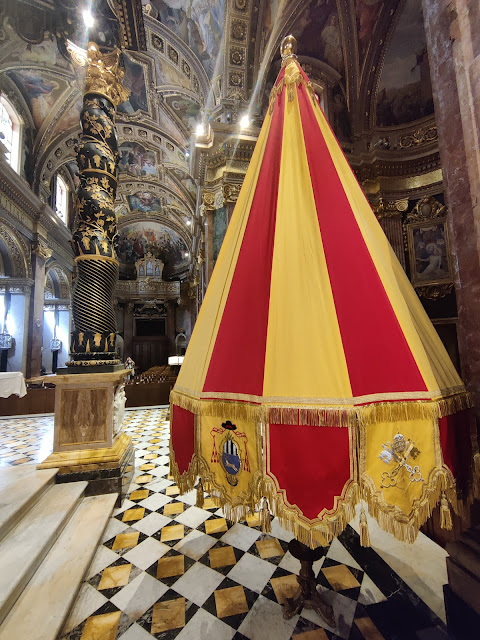 **The umbraculum or ombrellino is an umbrella, which in times past was used on a daily basis to provide shade for the pope when outside. In modern usage, the umbraculum is a symbol of the authority of the Pope. The umbraculum, made in the traditional papal colors of red and yellow, is placed in basilicas on the right side of the altar. Major basilicas have an umbraculum made of red and gold velvet; minor basilicas have an umbraculum made of red and yellow silk. Once placed in its rightful place in the sanctuary, it remains partially opened ready to welcome the Holy Father. Whenever the Pope visits a basilica, the umbraculum is opened in his honor. Each basilica has different symbols embroidered upon it. Such symbols are the shield of the basilica itself, the shield of the Pope who raised the church to a basilica, the shield of the diocese, and possibly the shield of the country in which the basilica resides.
**The umbraculum or ombrellino is an umbrella, which in times past was used on a daily basis to provide shade for the pope when outside. In modern usage, the umbraculum is a symbol of the authority of the Pope. The umbraculum, made in the traditional papal colors of red and yellow, is placed in basilicas on the right side of the altar. Major basilicas have an umbraculum made of red and gold velvet; minor basilicas have an umbraculum made of red and yellow silk. Once placed in its rightful place in the sanctuary, it remains partially opened ready to welcome the Holy Father. Whenever the Pope visits a basilica, the umbraculum is opened in his honor. Each basilica has different symbols embroidered upon it. Such symbols are the shield of the basilica itself, the shield of the Pope who raised the church to a basilica, the shield of the diocese, and possibly the shield of the country in which the basilica resides.
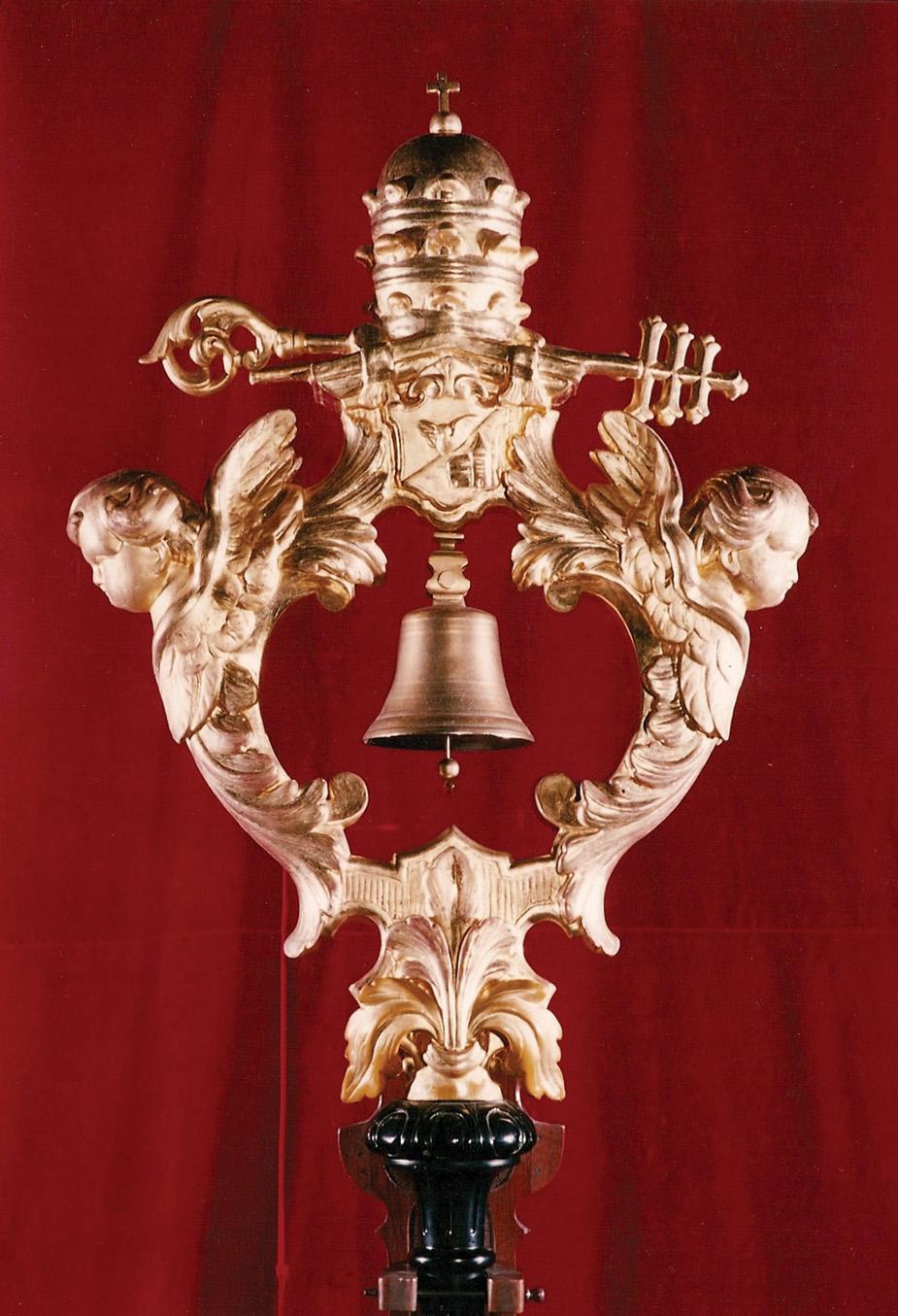 **The tintinnabulum, which means "little bell," is another symbol of a basilica. It consists of a gold bell mounted on a pole. On the pole are placed the papal symbol of the tiara and crossed keys. In the Middle Ages and the Renaissance, the tintinnabulum was carried in processions to alert the people of Rome of the approach of the Pope. Whenever the Holy Father visits a basilica, the tintinnabulum would lead the procession into the basilica. Each tintinnabulum is specific to the basilica in which it resides.
**The tintinnabulum, which means "little bell," is another symbol of a basilica. It consists of a gold bell mounted on a pole. On the pole are placed the papal symbol of the tiara and crossed keys. In the Middle Ages and the Renaissance, the tintinnabulum was carried in processions to alert the people of Rome of the approach of the Pope. Whenever the Holy Father visits a basilica, the tintinnabulum would lead the procession into the basilica. Each tintinnabulum is specific to the basilica in which it resides.
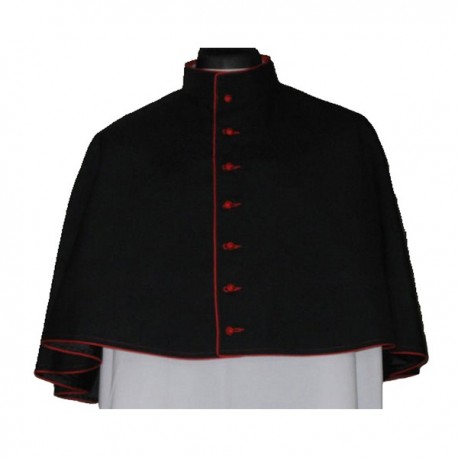 The final indication of a basilica is that of a mozzetta. The mozzetta is a short cape that covers the shoulders and is buttoned over the breast. It usually goes to elbow length. In ecclesiastical dress, it is normally worn by the pope, cardinals, bishops, abbots, and other dignitaries. The color of it denotes the office: white for the pope, scarlet for cardinals, amaranth red (fuschia) for bishops, and black for abbots. In recognition of his link to the Holy Father, the rector of a basilica may choose to wear a black mozzetta with red piping, buttons, and button holes. It would be worn over the cassock or religious habit and the surplice when he is exercising the duties of his office.
The final indication of a basilica is that of a mozzetta. The mozzetta is a short cape that covers the shoulders and is buttoned over the breast. It usually goes to elbow length. In ecclesiastical dress, it is normally worn by the pope, cardinals, bishops, abbots, and other dignitaries. The color of it denotes the office: white for the pope, scarlet for cardinals, amaranth red (fuschia) for bishops, and black for abbots. In recognition of his link to the Holy Father, the rector of a basilica may choose to wear a black mozzetta with red piping, buttons, and button holes. It would be worn over the cassock or religious habit and the surplice when he is exercising the duties of his office.
**In the 1989 document Domus Ecclesiae (Norms for the Granting of the Title of Minor Basilica) from the Congregations for Divine Worship and Discipline of the Sacraments, the umbraculum and tintinnabulum are no longer required to be displayed in basilicas. Our Lady of Consolation, though granted the title prior to 1989, does not have either of these symbols.
Basilica Information
Click below for all the information you may want to know about basilicas in general and specifically to Our Lady of Consolation.
Significance of Basilicas - Information on the Background and Types of Basilicas
Symbols of Basilicas - Information on symbols that designate a basilica
Responsibilities & Privileges - Information on Responsibilities a basilica has and the privileges it enjoys!
Significance of Basilicas
A Brief Background on Basilicas
The term basilica (lit. "royal stoa") comes from Ancient Greek and is the Latin equivalent of a stoa in the Greek East. A stoa is a covered walkway or portico usually for common (public) use. Basilica originally referred to a specific function and style of building in the ancient Roman Empire. Basilicas were normally rectangular with a central nave with long aisles on both sides. The roof was generally higher over the central nave and lower on the adjacent aisle. The structure was usually distinguished by ornate columns and had an apse (a semicircular recess covered by a vault or dome). Within the apse, the tribune (a raised platform) was placed and occupied by the Roman magistrates or the Emperor who sat in large ornate chairs. Basilicas were public buildings—commonly adjacent to the forum—and used by the Emperor or Judges for major events. The first known basilica was constructed in 184 BC and called the Basilica Porcia. Basilicas were also built as private residences and were known as palace basilicas.
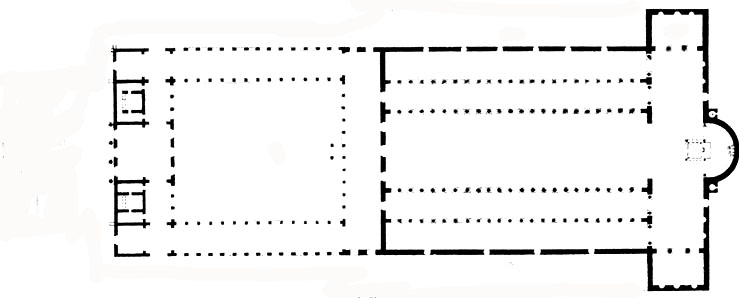
The layout of old Saint Peter's basilica.
After Constantine legalized Christianity, many basilicas were converted into churches. In the apse where the Emperor or Magistrates once stood, the altar and tabernacle were placed. With Our Lord Jesus Christ substantially present in the Eucharistic Sacrifice and reserved in the tabernacle, the basilica continued to be a "royal house" with the King of the Universe occupying his rightful place. Also placed within the apse was the chair of the bishop or priest who acts in persona Christi capitis ("in the person of Christ the Head"). Many churches throughout Europe and the Mediterranean were built with a basilica-style layout and in latter centuries, the style spread throughout the world. In the Catholic Church, the term basilica has now come to refer to certain churches of signficance without regard to the architectural form.
Two Types of Basilicas
There are two types of basilicas – Major Basilicas and Minor Basilicas. All four of the major basilicas are found within the city of Rome and are known as "papal basilicas".
Major Papal Basilicas
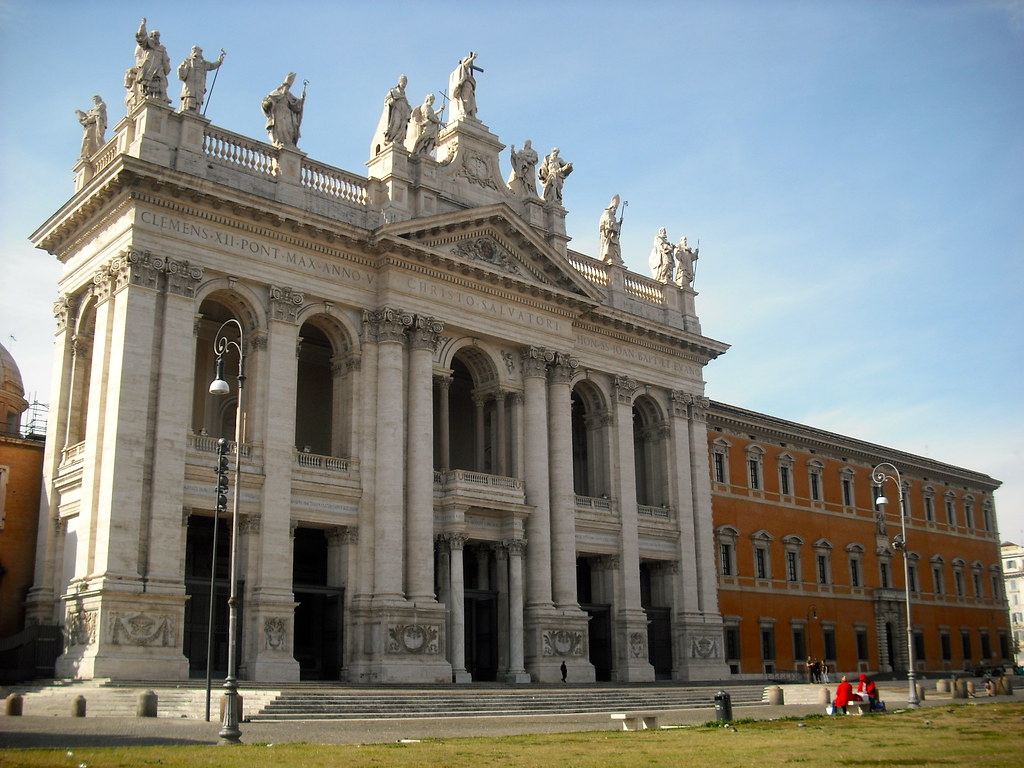 The first of the major basilicas is the Archbasilica of Saint John Lateran. Its full name is the Archbasilica Cathedral of the Most Holy Savior and of Saints John the Baptist and the Evangelist in the Lateran. This palace basilica of Constantine the Great was gifted to Pope Miltiades in 313 to be used for a synod of bishops. Pope Sylvester I converted it into his residence and then ultimately into the Cathedral of Rome. It was officially dedicated in 324. The Lateran Basilica continues to be the cathedral of Rome and thus the Pope's cathedral. On the basilica a inscription reads "Most Holy Lateran Church, mother and head of all the churches in the city and the world" which shows that Saint John Lateran is the mother church of every other Catholic Church in the world.
The first of the major basilicas is the Archbasilica of Saint John Lateran. Its full name is the Archbasilica Cathedral of the Most Holy Savior and of Saints John the Baptist and the Evangelist in the Lateran. This palace basilica of Constantine the Great was gifted to Pope Miltiades in 313 to be used for a synod of bishops. Pope Sylvester I converted it into his residence and then ultimately into the Cathedral of Rome. It was officially dedicated in 324. The Lateran Basilica continues to be the cathedral of Rome and thus the Pope's cathedral. On the basilica a inscription reads "Most Holy Lateran Church, mother and head of all the churches in the city and the world" which shows that Saint John Lateran is the mother church of every other Catholic Church in the world.
The other major basilicas are:
- Saint Peter's Basilica — also known as the Vatican Basilica (seen to the right). The basilica is built over the burial place of Saint Peter the Apostle. The current basilica
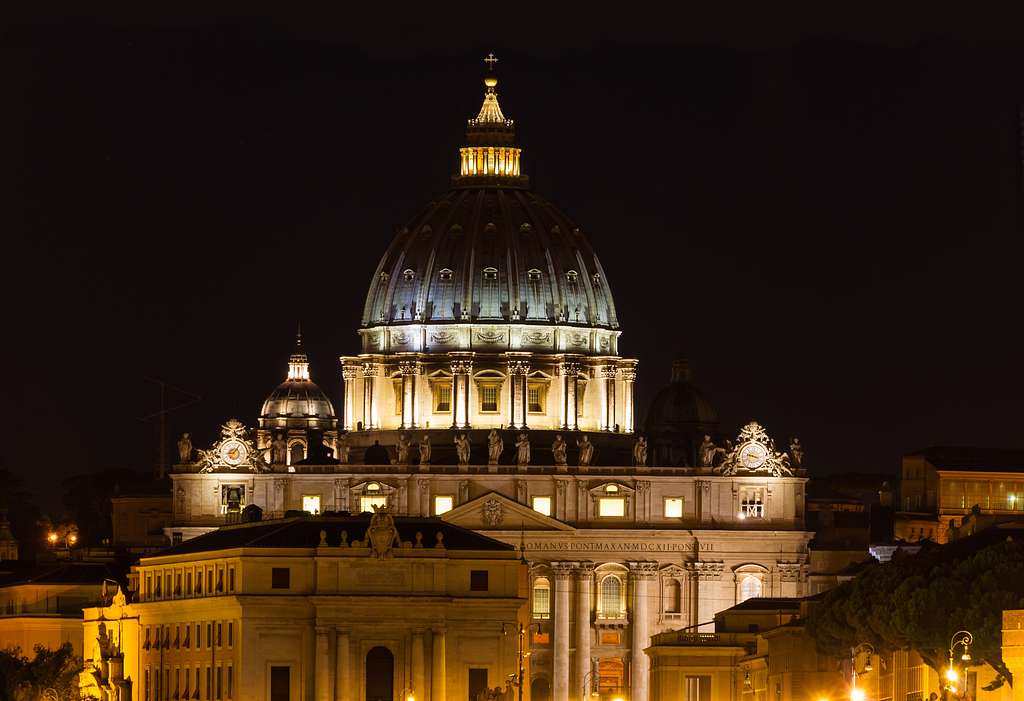 was conscrated on November 18, 1626.
was conscrated on November 18, 1626. - Saint Paul Outside-the-Walls — built over the grave of Saint Paul the Apostle. Like the basilica of Saint John Lateran, Pope Sylvester consecrated the orginial Saint Paul Outside-the-Walls in 324.
- Saint Mary Major — enshrines an image of our Blessed Mother as the health and protectress of the Roman People. The image is called Salus Populi Romani. The basilica is the largest Catholic Marian church in Rome.
All of the major papal basilicas have a holy door which are only opened by the Pope himself during Jubilee years. Those who pass through a holy door are able to gain a plenary indulgence when fulfilling the usual conditions.
Minor Papal Basilicas
In addition to the four major papal basilicas, there are three minor papal basilicas:
- Saint Lawrence Outside-the-Walls (located in Rome) — built over the burial site of Saint Lawrence, one of the first seven deacons of Rome and martyred in 258.
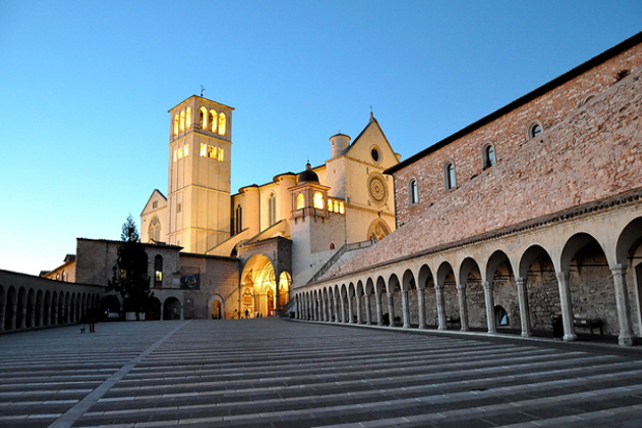
- Basilica of Saint Francis of Assisi (located in Assisi - seen to the right) — mother church of the Order of Friars Minor Conventual. Construction was begun by Pope Gregory IX in 1228 the day after he canonized Francis. The basilica was consecrated in 1253 by Pope Innocent IV and in 1288, Pope Nicholas IV—the first Franciscan to be elected pope—declared the basilica a "papal church."
- Basilica of Saint Mary of the Angels (located in Assisi) — built surrounding the Portiuncola, the little church where Saint Francis of Assisi realized his vocation, started the Franciscan order, and ultimately died in his cell. Pope Pius X raised the church to a papal basilica in 1909.
Other Minor Basilicas
In addition to the papal minor basilicas, there are Pontifical Minor Basilicas, Patriarchal Minor Basilicas, and finally Eccesiastical Minor Basilicas, the last being the category having the most. Usually referred to just as minor basilicas, all the aforementioned churches throughout Christendom have been given a special designation by the Holy Father. The title of minor basilica may be bestowed by the Holy Father because of the church's architectural beauty, historical significance, and liturgical renown—especially in regards to the Holy Mass, penance, and other sacraments. Other possible reasons include that the body or significant relics of a saint is reserved in it or a sacred image is venerated there in a special way.
A minor basilica shares a special relationship with the Holy Father. Various privileges granted to and obligations required of the minor basilica highlight this important attachment to the Holy See and the Supreme Pontiff. Once a church has been granted basilica status, it can never lose that status, nor can it ever be closed without the permission of the Holy Father.
Letters from the Rector/Pastor
Letters from Fr. Thomas Merrill, the Rector & Pastor of Our Lady of Consolation, can be viewed here. These letters have either been printed in the bulletin or placed as an insert in the bulletin.
February 11, 2024 - Scapular Letter
February 4, 2024 - World Day of the Sick
December 3, 2023 - Advent Letter
December 3, 2023 - Consecutive Holydays (4th Sunday of Advent & Christmas)







